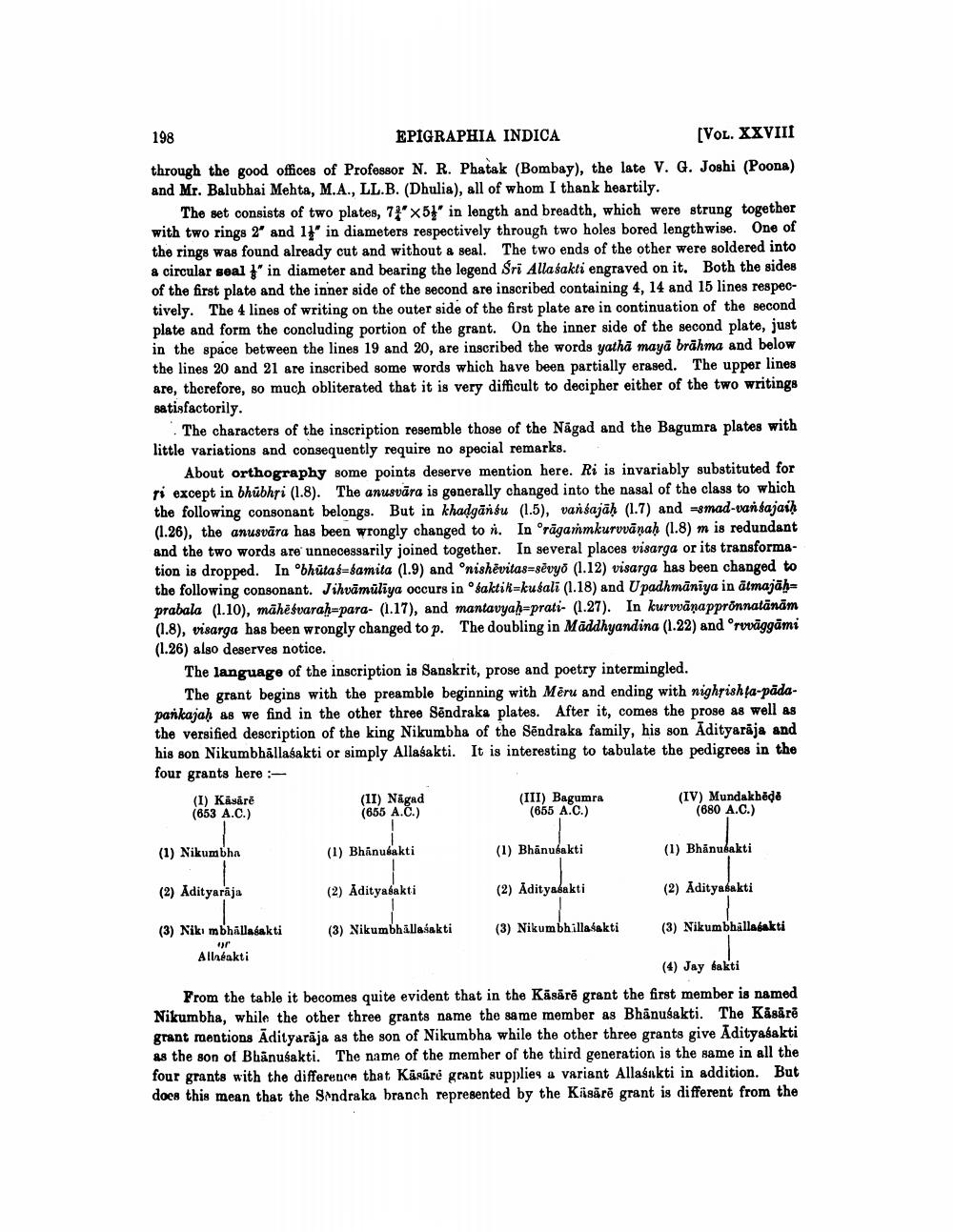________________
198 EPIGRAPHIA INDICA
[Vol. XXVIII through the good offices of Professor N. R. Phatak (Bombay), the late V. G. Joshi (Poona) and Mr. Balubhai Mehta, M.A., LL.B. (Dhulia), all of whom I thank heartily.
The set consists of two plates, 7" x 51' in length and breadth, which were strung together with two rings 2 and 1l' in diameters respectively through two holes bored lengthwise. One of the rings was found already cut and without a seal. The two ends of the other were soldered into a circular sealt" in diameter and bearing the legend Sri Alla sakti engraved on it. Both the sides of the first plate and the inner side of the second are inscribed containing 4, 14 and 15 lines respectively. The 4 lines of writing on the outer side of the first plate are in continuation of the second plate and form the concluding portion of the grant. On the inner side of the second plate, just in the space between the lines 19 and 20, are inscribed the words yathā mayā brāhma and below the lines 20 and 21 are inscribed some words which have been partially erased. The upper lines are, therefore, so much obliterated that it is very difficult to decipher either of the two writings satisfactorily.
The characters of the inscription resemble those of the Nagad and the Bagumra plates with little variations and consequently require no special remarks.
About orthography some points deserve mention here. Ri is invariably substituted for ri except in bhūbhri (1.8). The anusvāra is generally changed into the nasal of the class to which the following consonant belongs. But in khadgānếu (1.5), vançajāh (1.7) and =smad-vansajaih (1.26), the anusvāra has been wrongly changed to n. In orāgammkurvvānah (1.8) m is redundant and the two words are unnecessarily joined together. In several places visarga or its transformation is dropped. In bhūtas-samita (1.9) and 'nishēvitas=sèvyo (1.12) visarga has been changed to the following consonant. Vivāmūliya occurs in osaktik=kusali (1.18) and Upadhmāniya in ātmajāh= prabala (1.10), māhësvarah-para- (1.17), and mantavyah-prati- (1.27). In kurvvänapprõnnatānām (1.8), visarga has been wrongly changed to p. The doubling in Mäddhyandina (1.22) and Preväggāmi (1.26) also deserves notice.
The language of the inscription is Sanskrit, prose and poetry intermingled.
The grant begins with the preamble beginning with Mēru and ending with nighrishta-pādaparkajah as we find in the other three Sēndraka plates. After it, comes the prose as well as the versified description of the king Nikumbha of the Sēndraka family, his son Adityarāja and his son Nikumbbállasakti or simply Allasakti. It is interesting to tabulate the pedigrees in the four grants here - (I) Käsare (II) Någad (III) Bagumra
(IV) Mundakbeda (653 A.C.) (655 A.C.) (655 A.C.)
(680 A.C.)
(1) Nikumbha
(1) Bhānubakti
(1) Bhānusakti
(1) Bhānusakti
(2) Adityarāja
(2) Adityabakti
(2) Adityasakti
(2) Adityasakti
Or
(3) Niki mbhallasakti (3) Nikumbhallasakti (3) Nikum bhillasakti (3) Nikumbhallabakti Alnéakti
(4) Jay sakti From the table it becomes quite evident that in the Kāgārē grant the first member is named Nikumbha, while the other three grants name the same member as Bhanusakti. The Käsirë grant mentions Adityarāja as the son of Nikumbha while the other three grants give Adityasakti as the son of Bhånusakti. The name of the member of the third generation is the same in all the four grants with the difference that Kirare grant supplies a variant Allasnkti in addition. But does this mean that the Sandraka branch represented by the Kiisárē grant is different from the




